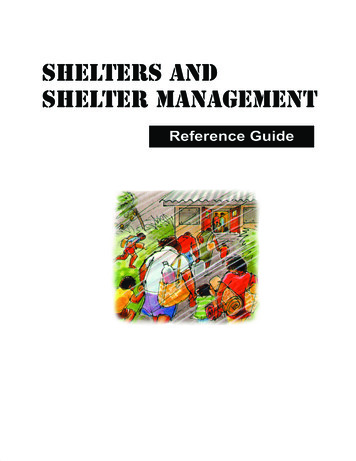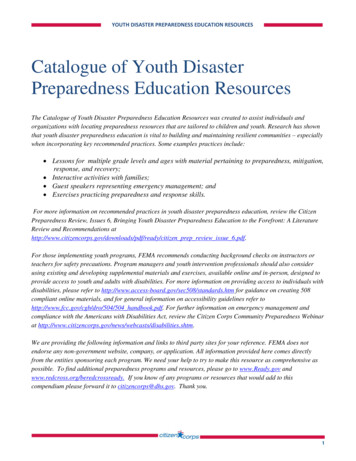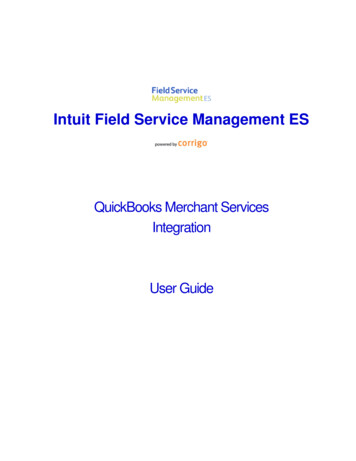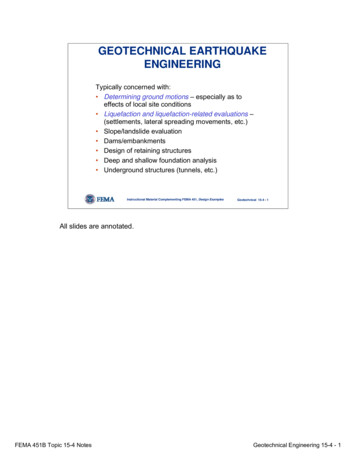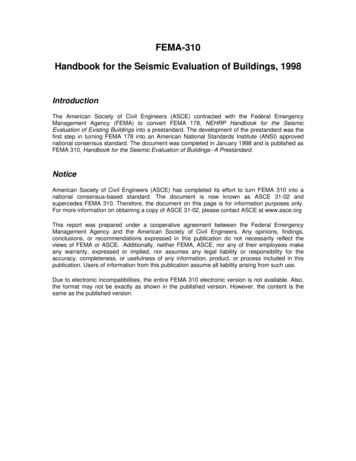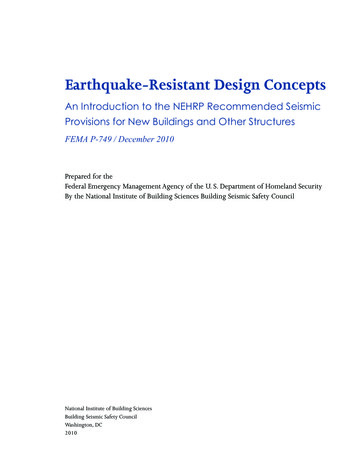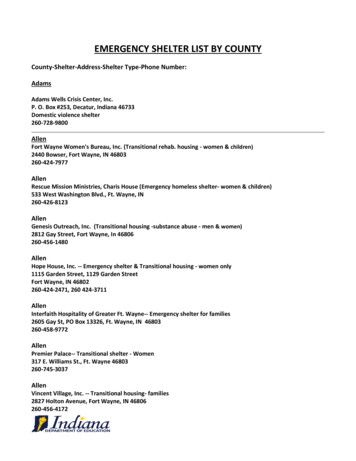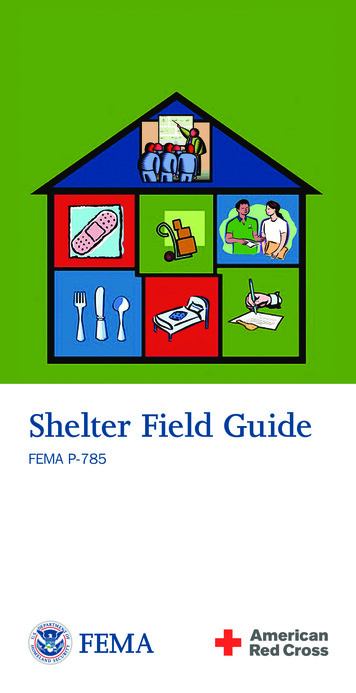
Transcription
Shelter Field GuideFEMA P-785
Shelter Field GuideWith contribution from:American Red CrossFederal Emergency Management AgencyMissouri State Emergency ManagementNew York City Department of Homeless ServicesSan Francisco Department of Emergency Management
Table of ContentsIntroduction .1Fundamental Objectives of Sheltering.2Using This Guide.3 Design.3 Position Icons.4 Training.4Before Opening A Shelter.5Determine if the Shelter Is Necessary.5Establish Relationships with Local Emergency Management.5Complete a Site Review.6Determine the Scope of Shelter Services Needed.6Site Layout and Setup.7 Parking Areas.7 Drop-off Area.7 Waiting Area.7 Registration Area.7 Dormitory Areas.8 Children and Family Areas.8 Household Pets Area.8 Feeding/Food Preparation and Serving Areas.8 Snack Area.9 Health Services and Mental Health Services Areas.9 Lounge and/or Recreation Areas.9 Storage Areas.9 Shelter Management Offices.9 Staff Area.9Sample Shelter Floor Plan.10Establish Shelter Rules.11Staffing.11 Shelter Positions.12 Considerations When Planning Staffing.12 Forecasting Staffing Needs.12 Shifts.13 Scheduling.13 Orienting Your Staff.13 Keeping Track of Your Staff.13 Resident Volunteers.14Shelter Field Guideii
Sample Staffing Chart.15Sample Organizational Chart.16Staffing Shortage/Overage Challenges.17 Staff Shortages.17 Staff Overages.17Logistics.17 Identify Potential Resources.17 Procurement.18Safety and Security.18 Assessing Shelter Security.18 Potential Security Issues.19 Security Precautions.19 Safety and Security Incident Documentation.20Fire Safety.20Access and Functional Needs Support Services.21 People with Visual Disabilities.22 People Who Are Deaf or Hard of Hearing.22 People with Mobility Disabilities.22 People with Cognitive, Intellectual and MentalHealth Disabilities.22 Service Animals.23 Household Pets.24Other.25Opening a Shelter.26Establish Schedules for Daily Activities.26Registration Staff Duties.27 #1 Register Residents.27 #2 Conduct an Initial Health and Mental HealthScreening.28 #3 Identify Unaccompanied Minors.28 Shelter Residents Whose Legal Status AffectsTheir Placement In Shelter Housing.28 Privacy and Information Sharing.29 Dormitory Management.29 Health Services and Mental Health Services.30 Common Mental Health Concerns in Shelters.31 Preventing Contagious Disease Outbreaks.31Feeding.33Shelter Field Guideiii
Logistics.33 Site Maintenance and Custodial Services.33 Inventory Management.34 Inventory Management Challenges.35Monetary and Material Donations.35Communication.36 Residents.36 Shelter Staff.37 General Public.37 Media.37 Supporting Agency and Local EOC.38Ongoing Shelter Operations.39Reporting.39 Establish the Reporting Structure.39 Create and Implement Reporting Tools.39Adjusting Operations to Changing Requirements.40 Utilizing Shelter Resident Leadership.40 Competing Priorities.41 Inadequate Shelter Space/Overcrowding.41Reunification Services.41Transportation.42Closing a Shelter.43Shelter Closing Considerations.43Shelter Closing Coordination.44Closing Schedule.45Document Retention.45Checklists.46Shelter Operation Functions.46Using the Checklists.47Shelter Manager Checklist.48 Opening.48 Ongoing.49 Closing.50Registration Checklist.51 Opening.51 Ongoing.52 Closing.52Shelter Field Guideiv
Feeding Checklist.53 Opening.53 Ongoing.54 Closing.55Dormitory Checklist.56 Opening.56 Ongoing.57 Closing.57Staffing Checklist.58 Opening.58 Ongoing.58 Closing.58Logistics Checklist.59 Opening.59 Ongoing.60 Closing.60Health Services and Mental Health Services Checklist.61 Opening.61 Ongoing.61 Closing.62Coaching Aids.63Preparing to Train. 63Shelter Manager Coaching Aid.64 Self Study.64 Discussion Points.64 Demonstrate.65 Observe.65 Reinforce.65Registration Coaching Aid.66 Self Study.66 Discussion Points.66 Demonstrate.67 Observe.67 Reinforce.67Feeding Coaching Aid.68 Self Study.68 Discussion Points.68 Demonstrate.69Shelter Field Guidev
Observe.69 Reinforce.69Dormitory Coaching Aid.70 Self Study.70 Discussion Points.70 Demonstrate.71 Observe.71 Reinforce.71Staffing Coaching Aid.72 Self Study.72 Discussion Points.72 Demonstrate.73 Observe.73 Reinforce.73Logistics Coaching Aid.74 Self Study.74 Discussion Points.74 Demonstrate.75 Observe.75 Reinforce.75Health Services and Mental Health Services Coaching Aid.76 Self Study.76 Discussion Points.76 Demonstrate.77 Observe.77 Reinforce.77Resources .78 Resource Links.78 Contacts.81Shelter Field Guidevi
IntroductionPlease remember that all disasters are different and, consequently,conditions caused by the disaster may require flexibility ininterpretation and application of this guide. This flexibility does notinclude issues pertaining to civil rights law protections. Contactlocal emergency management or your supporting agency with anyquestions.Shelter Field Guide1INTRODUCTIONThe operation of emergency shelters helps communities providea safe and secure place for individuals and families to stay before,during and/or after a disaster. The Shelter Field Guide is intendedto provide organizations without prior disaster experience with abasic overview of shelter operations that will help them to openand manage an emergency shelter. The Guide also containsinformation helpful to organizations that may wish to supportthe operation of a shelter, such as churches, service clubs, orbusinesses. The Guide refers to an organization acting in thiscapacity as a “supporting agency.”
Shelters provide a safe place for individuals and familiesaffected by a disaster to sleep or rest and may offer, amongother things, food, snacks, beverages, cots, blankets,sanitation facilities, safety, first aid and information onrecovery efforts. Shelters provide services to everyone in the community. Shelter staff abide by principles of confidentiality whenhandling shelter resident information. Shelter staff strive to accommodate the varying cultural andfaith-based preferences of the residents. Such requirementscould include variations in sleeping, eating and other areasas well as the provision of space to meet and honor spiritualneeds. As required by the Americans with Disabilities Act (ADA) andother civil rights laws, shelters must accommodate individualswith disabilities and those who support them. Take steps toensure that every individual with a disability can fully useand enjoy the programs, services, activities, goods, facilities,privileges, advantages and accommodations provided by theshelter operator and their supporting agencies. Shelter residents who need acute health care that extendbeyond the capacity of a shelter should be provided access toa medical facility.Shelter Field Guide2INTRODUCTIONFundamental Objectives of Sheltering
DesignThis guide is designed to be used in the field throughoutthe sheltering cycle. It is divided into eight sections. On theright side of each page is a vertical color bar to assist you innavigating the guide with ease. The sections and color codesare as follows: Introduction Before Opening a Shelter Opening a Shelter Ongoing Shelter Operations Closing a Shelter Checklists Coaching Aids ResourcesShelter Field Guide3INTRODUCTIONUsing This Guide
Position IconsShelter ManagementRegistrationFeedingDormitory ManagementStaffingLogisticsHealth Services and Mental Health Services TrainingAt the end of this guide are two sections related to training: Checklists Coaching AidsThe Checklists section contains a list of tasks for seven shelterpositions. These lists can be removed from the Guide andgiven to trainees to assist them in learning their position. Theycan also be photocopied and used to track work daily.The Coaching Aids section provides tools for instructors to usewhen training staff.Shelter Field Guide4INTRODUCTIONIn addition to the color coded sections, the Guide containsinformation on the seven fundamental functions within a shelter.A set of icons has been developed representing each of thefunctional staffing areas of a shelter. At the beginning of eachsection and above certain sub-sections, you will find iconsthat indicate the kind of information that section presents. Theposition icons are as follows:
Before Opening a ShelterThis section of the Shelter Field Guide will help to ensure that youhave covered all the bases before opening a shelter.NOTE: Contact the American Red Cross to learn more aboutsheltering, shelter partnering opportunities and benefits, andtraining that may be available near you.Determine if the Shelter is NecessaryCheck with your local emergency management agency to see ifthere are other nearby shelters already operating. If there are,opening another shelter may actually be counterproductive,as it may cause confusion, unduly strain scarce resources, oroverburden logistical support.Establish Relationships with Local EmergencyManagementOne key to a successful shelter operation is close coordinationwith local emergency management and other organizationssupporting shelters. Local emergency management often opens an EmergencyOperations Center (EOC) when a disaster or significant eventoccurs. The local EOC is the primary coordination center forthe jurisdiction. The Shelter Manager should determine who the point ofcontact (POC) is that the local EOC establishes. The local EOC is a coordinator of services, not a provider. Not all resources will be available locally.Shelter Field Guide5BEFORE OPENING A SHELTERBefore opening a shelter, there are a number of things to consider.Is a shelter necessary? Is the selected site appropriate forsheltering? Does the shelter site comply with the requirementsof the Americans with Disabilities Act (ADA) and other civil rightslaws? How will the shelter be publicized and supported? Who willpay for the cost of operating a shelter?
To ensure a safe and healthy shelter environment, conduct aninspection of the facility prior to opening and consider the followingliability, safety and security issues: Is the facility in a safe location near the affected area? Is the facility clean and orderly? Are kitchen and bathroomsfunctional and sanitary? Is there sufficient light in public areas? Are the building systems in working order (electrical, water,sewage, heat, ventilation and air conditioning)? Are the fire extinguishers and smoke detectors in workingorder? Are indoor and outdoor walkways open and free of hazards? Are the emergency exits clearly identified and unobstructed? Is the facility accessible to children and adults who may usemobility devices such as wheelchairs or canes? Does accessto and within the facility require climbing stairs? Are first aid kits readily available and fully stocked? Where? Is there an emergency evacuation plan and identified meetingplace? Will occupants be notified that an emergency evacuation isnecessary by a public address system or alarm? Are there any hazardous materials or equipment onsite? If so,are they secured? Are there any pre-existing safety/fire hazards such as missingelectrical covers, inappropriate use of extension cords, orimproperly stored flammable materials?Determine the Scope of Shelter Services NeededServices should meet a variety of individual andcommunity needs, including: Culturally appropriate meals and allocation of space Health and mental health servicesShelter Field Guide6BEFORE OPENING A SHELTERComplete a Site Review
Assistance for: Children Elderly Children and adults with access or functional needs Individuals with limited English proficiencySite Layout and SetupWhen allocating space in the shelter, consider establishing thefollowing areas as well as the level of access to each area. Someareas will need to be restricted from the general population, suchas supply storage areas, classrooms, libraries, or any area thathas supplies or equipment that are dangerous or may be broken.NOTE: Post signs indicating that the building is a shelter as wellas signs to direct people to the different areas inside the shelter. Parking AreasIdentify areas for resident, staff and visitor parking. Drop-off AreaKeep main entrance clear for emergency vehicles andaccessible for resident drop off. Waiting AreaIdentify an area to accommodate residents waiting to register.When possible, identify climate controlled areas, or areas thatare protected from the elements. Include seats for those whoare unable to stand. Make accessible restrooms and drinkingwater available. Registration AreaIdentify an area near the facility’s main entrance for registrationof residents. When setting up the registration area: Position several tables and many chairs by the mainentrance to receive residents. Allow for one registration worker at each table. Allowenough space for privacy when clients are providingregistration information. Use one table for Health Services and Mental Health Services. Use only one facility entrance, if possible. Position staff atother entrances to direct shelter residents.Shelter Field Guide7BEFORE OPENING A SHELTER Infants
Dormitory Areas Ability to dim lights. Distance from internal and external traffic. Independent temperature control. Separate spaces for families, women, men and other groups. One toilet for 20 persons is recommended; if the shelterhas only one toilet, it must be accessible for people withdisabilities. (A minimum of 1 toilet for every 6 persons mustbe accessible for people with disabilities.) An approximate ratio of 1 shower for every 25 persons isrecommended; if the shelter has only one shower, it mustbe accessible for people with disabilities. (A minimum of 1shower for every 6 persons must be accessible for peoplewith disabilities.) Set up cots and blankets. Children and Family AreasEstablish specific areas for the following: Children’s recreation Diaper changing Breast feeding Bottle washing Temporary respite care—a supervised area for children Household Pets AreaShelter household pets in distinct facilities designed to shelteranimals. Feeding/Food Preparation and Serving AreasIf meals are produced on site, a commercial kitchen isdesirable. If meals are catered, a staging area is needed. Set up a beverage and snack area. Identify sources for food, water, feeding support materialsand equipment. Determine when the first meal will be served. Establish a schedule for meals. Set up dining area that is located away from the dormitory. Post signage that states that no food can be taken to thedormitory area.Shelter Field Guide8BEFORE OPENING A SHELTERProvide areas for cots or mats. Allow 40 square feet of space perperson, unless additional space is required for a service animal,wheelchair, or other assistive aid. Consider the following:
Plan to offer meals based on several considerations: Availability of food Convenience of procurement Cultural concerns Health condition of shelter residents CostEvaluate staffing needs in order for meal service to function ina timely manner. Consider staffing the following: Kitchen supervisor Cook and helpers Food prep staff Dish washers Servers Clean-up crew Snack AreaEstablish an area where food and beverages will be available24 hours a day. Health Services and Mental Health Services AreasSet up separate areas that provide privacy for residentsseeking health and/or mental health services. Lounge and/or Recreation AreasEstablish lounge and/or recreation areas. Ensure that a quietarea for religious, spiritual, or meditative use is available. Storage AreasIdentify locked storage areas for food and facility supplies. Shelter Management OfficesEstablish private offices with telephones and computers for theshelter manager and staff preparing reports. Staff AreaEstablish a private area for staff to take a break, rest, orcomplete administrative duties.Shelter Field Guide9BEFORE OPENING A SHELTERNOTE: All food service areas must be accessible to everyshelter resident.
Sample Shelter LayoutShelter Field Guide10BEFORE OPENING A SHELTERSample Shelter Floor Plan
Establish Shelter Rules No drugs, alcohol, weapons, or pets are permitted. Smoking – Use of all tobacco products, matches, or lightersinside the shelter is prohibited. Children – Parents are responsible for keeping track of andcontrolling the actions of their children. Do not leave childrenunattended. Personal belongings – Shelter staff cannot assumeresponsibility for belongings. Lock valuables in your car, out ofsight, or keep valuables with you. Sleeping areas are quiet areas at all times of the day andnight. Quiet hours with lights out are enforced in the sleepingareas between the posted hours (e.g., 10:00 p.m. to 6:00a.m.). Residents leaving the shelter for any period of time must signout and sign in at the registration area. Keep your areas clean. Help clean up of other areas whenpossible. Food and drinks, other than water, are not allowed in thesleeping area. Be respectful and courteous to others at all times. Loud,boisterous and disruptive behavior is not permitted. Immediately report all health or safety concerns to shelterstaff.StaffingOne of the greatest challenges in operating a shelter is recruitingand maintaining adequate staff.NOTE: Every shelter needs a shelter manager who isqualified to provide support and supervision of all functionsto ensure that residents’ needs are met. It is important todelegate tasks to competent subordinates in order for theshelter to run smoothly.Shelter Field Guide11BEFORE OPENING A SHELTERBelow are sample shelter rules. It is recommended that shelterrules be posted in all areas of the shelter in the languages of theresidents.
Shelter Positions Shelter Manager and Shift Supervisor Registration Feeding Dormitory Staffing Logistics Health Services and Mental Health Services Considerations When Planning StaffingDetermine the number of shelter staff needed based on thesefactors: Anticipated number of shelter residents Safety concerns Ability to secure the facility Anticipated duration of shelter operation Demographics of shelter residents, especially children andpeople requiring access and functional needs services(FNSS) Layout of the shelter Forecasting Staffing NeedsIn planning for the staffing of the shelter, consider the following: Assign one Shelter Manager for the entire operation. Assign a Shift Supervisor for each shift. Assign a Staffing position to recruit, orient, train and trackthe staff. Assign shelter staff to lead key responsibilities. Some staffcan be assigned more than one responsibility dependingon the size of the shelter population. Determine the number of Health Services and MentalHealth Services staff required based on the shelterpopulation and their needs.NOTE: When opening a shelter, it is recommended that therebe at least three staff members per shift, including a ShelterManager/Shift Supervisor, Registration Worker andFeeding/ Logistics Worker.Shelter Field Guide12BEFORE OPENING A SHELTERThe following staff are typically needed initially to open andoperate a shelter:
Shifts Start up the shelter with two 12-hour shifts. Transition to three 8-hour
Contact the American Red Cross to learn more about . sheltering, shelter partnering opportunities and benefits, and training that may be available near you. Determine if the Shelter is Necessary. Check with your local emergency management agency to see if . there a

